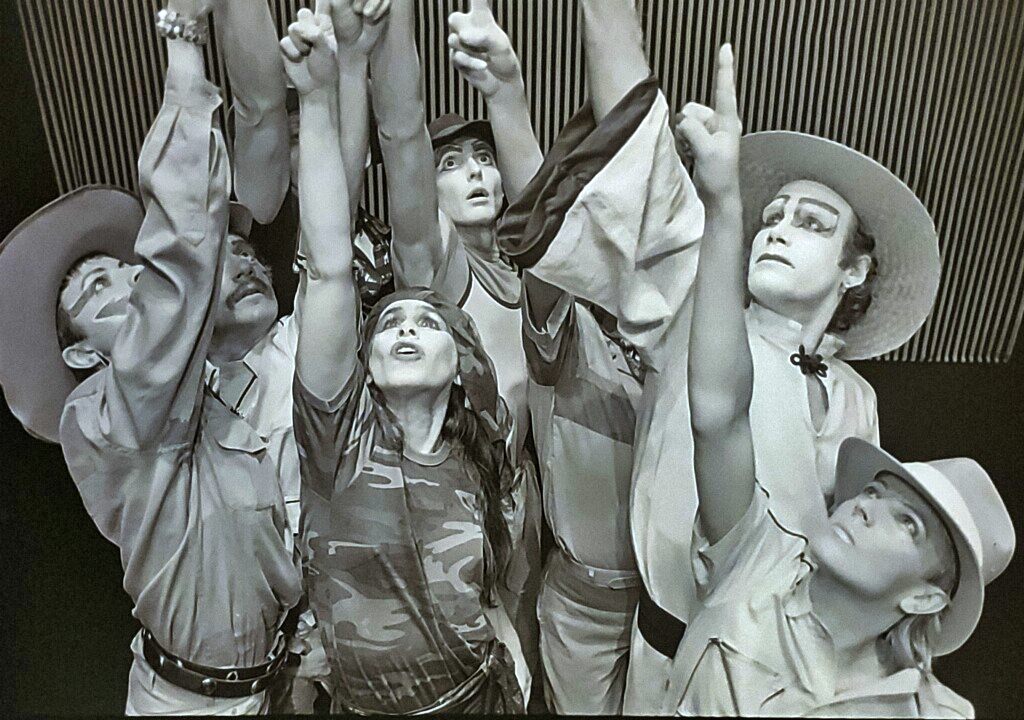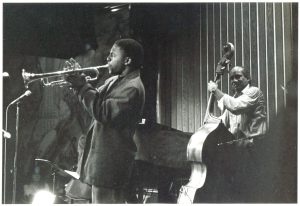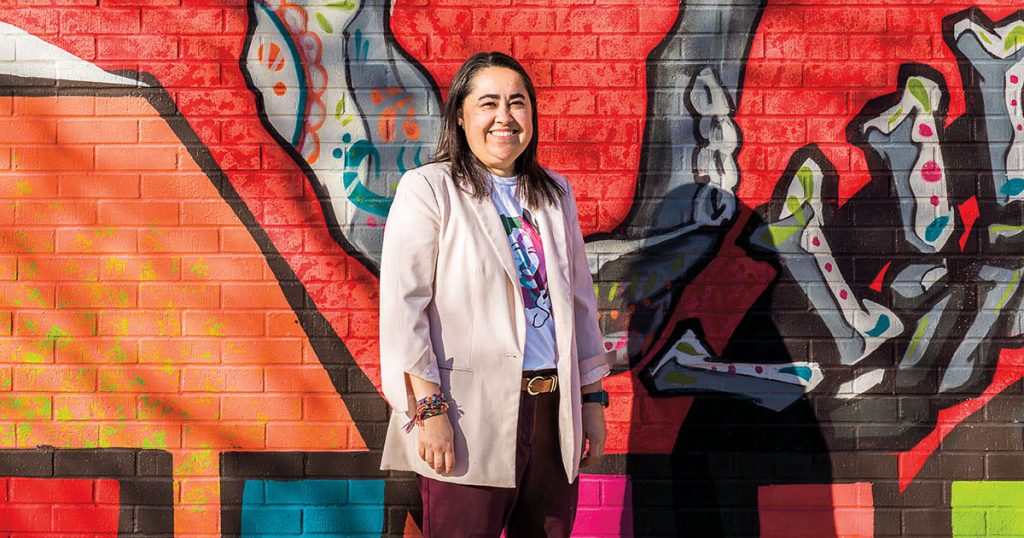
Performers for “Kabuki Blues,” an original drama created at Caravan of Dreams. Photo by Courtney Carroll
Forty years ago, a most unusual performance and arts space opened its doors in downtown Fort Worth. A two-story brick building on Houston Street built in the 1880s was repurposed into a music venue featuring jazz and blues, a record label and production company, a theater with its own touring ensemble, dance studio, art gallery, and a restaurant, topped by a rooftop cactus garden, grotto bar, and a geodesic dome.
The Caravan of Dreams was avant-garde, experimental, quirky, exotic, or the work of a cult, depending who you asked, and quite the anomaly—as if Parliament-Funkadelic’s Mothership had landed in the heart of Cowtown.
Music historian William Williams, who has been documenting music in North Texas for decades, still can’t get over the Caravan and its 18-year run as the coolest performing arts center in Texas. He decided to try and explain it all in Caravan from Dreamland: When Cowtown Conjured a New Frontier, a three-volume history, complete with hundreds of images, told through accounts of participants, staff, patrons, and fans, along with advertisements and news accounts.
“It’s a poignant story,” he said. “They did some amazing things, then it started to fade. And here I am sifting through the ashes.”
The idea for the performing arts space was hatched by Fort Worth’s Ed Bass—one of the four billionaire Bass brothers and nephew to Texas oil billionaire Sid W. Richardson. He created the group with ecologist John P. Allen and artist Kathelin Hoffman of the Synergia Ranch, an “ecovillage” commune of academics, artists, and scientists in New Mexico who were involved in ecological projects around the world.
Bass fell in with the Synergia Ranch folks in 1973 through a construction project in New Mexico and ended up joining The Theater of All Possibilities performing troupe. He funded Synergia projects around the globe, including an art gallery in London, a cattle ranch in Australia, and a hotel with a library and cultural center in Kathmandu. The collaboration helped fulfill Synergia’s mission to fuse together arts, sciences, and enterprise. “They were one of the more successful communes to come out of New Mexico, where there was a huge concentration of New Age communities,” Williams said.
After years of traveling with Synergia and the Theater of All Possibilities throughout the 1970s, Bass returned home, ready to breathe life into Fort Worth’s nonexistent nightlife. He opened the Caravan’s doors on Sept. 29, 1983. Fort Worth had never seen anything like it before, and nothing like it has come along since.

The Caravan of Dreams in downtown Fort Worth. Photo by Juan Trahan
The venue’s name was inspired by a couplet written by Bahaudin, the Sufi mystic: “Here we are, all of us: in a dream-caravan. A caravan, but a dream—a dream, but a caravan. And we know which are the dreams.”
The opening featured experimental jazz saxophonist Ornette Coleman, a native son returned to the hometown he long ago left behind, to debut his original composition Skies of America with the Fort Worth Symphony. After the performance, Coleman’s group Prime Time played the club over the opening weekend.
“Are they cultural pioneers, or rich folks or crazy people?” Diane Werts of the Dallas Morning News mused in an article about the opening. “Actually—delightfully—a little bit of all three.”
For the next eight years, a dream lineup of jazz and blues greats graced the Caravan’s music stage, among them Eartha Kitt, Cecil Taylor, the Art Ensemble of Chicago, Wynton Marsalis, Sun Ra, Hugh Masekela, and Herbie Hancock. The venue also hosted hometown acts the Juke Jumpers, Johnny Reno, Robert Ealey, and T-Bone Burnett, and a hot new guitarist named Stevie Ray Vaughan.
“People of all cultures and backgrounds showed up and had a good time,” wrote Fort Worth journalist Bob Ray Sanders. “It was a mecca for creative exchange that was broader than music, because there was poetry and film and theater. It was a cultural thing that was going on here.” Fans even drove over from Dallas, locals marveled, including professional athletes from the Dallas Cowboys and the Dallas Mavericks.

Born in Waco, the late American jazz musician and composer Roy Hargrove won two Grammy Awards. Photo by Juan Trahan
Psychedelic guru Timothy Leary, Beat Generation writer William Burroughs, anthropologist Jane Goodall, poet Yevengy Yevtushenko and John Allen/Dolphin delivered lectures and spoken word performances at the Caravan. Dance companies graced the theater stage. The Jubilee Theater’s performance of “Negroes in Space” drew record crowds, a big deal in the once-segregated city.
Eight years in, the variety of talent presented in the performing space broadened. Lyle Lovett, a Texas singer-songwriter-bandleader whose music was neither jazz nor blues, sold out five consecutive shows. Jerry Thompson, a principle in the Dallas Alley bar mall concept who had been hired as Caravan’s president, launched a six-month remodel that expanded capacity of the music room, while presenting rock bands like Little Feat and Los Lobos and singer-songwriters such as Lucinda Williams, in addition to featuring jazz, soul, and blues artists.
Thompson’s eye was on the bottom line, a novel concept at the Caravan. Operations became more efficient. “Some of the Synergists on the waitstaff weren’t specifically trained or experienced in those positions,” Williams allowed. But the Synergia people had moved on.
In 2001, the Caravan closed for good with a final performance by the nuclear polka band from Denton, Brave Combo. The Synergia folks were moving on to a bigger project, Biosphere II in Arizona, an experimental three-acre closed ecological system in which eight people would live that Bass helped underwrite. Bass shifted his Fort Worth focus to the Will Rogers complex on the west side, overseeing new facilities for national cutting horse competitions and the construction of the Dickies Arena, as well as riding in the city’s annual rodeo parade. A new tenant, the Reata Steakhouse, was moving in to the Caravan space.
As much as Bass and Synergia play major roles in the Caravan, it’s the other stories that make this history come alive. Marjorie Crenshaw, president of the FW Jazz Society, and the superfan Marie Holliday, are profiled in Williams’ work. So is artist and mask maker Leticia Eldridge, who speaks as a Caravan insider who wasn’t part of the Synergia group. The creations of the rooftop cactus garden, and the jazz and dance murals in the building are detailed.
The section recognizing I.M. Terrell High School band director G.A. Baxter and the future jazz greats he educated at the segregated school including Ornette Coleman, King Curtis, Ronald Shannon Jackson, Prince Lasha, Dewey Redman, and Cornell Dupree is enlightening, important scholarship. Several of these same players reunited to perform at the Caravan together.

Fort Worth native and performer Letitia Eldridge acts on stage with a masked singer. Photo courtesy William Williams
The Caravan of Dreams has been gone longer than its run lasted. Ed and Sasha Bass operate the Caravan of Dreams gallery downtown, using the original logo of the performing arts center. Downtown is a little quieter after dark. The action that once swirled around Sundance Square has moved to the Stockyards district.
Williams’ Caravan project stands as a reminder of what once was. “Everything under the sun has a time-stamped expiration date on it, even a performing arts center,” he says. “The decline and end is as important as the ascendent energy. You have to see it in its totality.“
Caravan from Dreamland: When Cowtown Conjured a New Frontier is available to download for free at Williams’ nonprofit Metro Music Project website.








